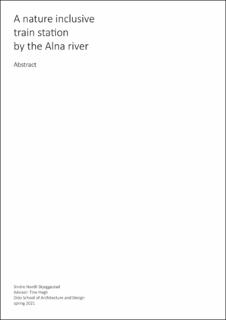A nature inclusive train station by the Alna river
Description
“How can we build our urban structures in a way that facilitates for an improved urban biodiversity?”
This question came from the ever more apparent reality that our biodiversity is dwindling, and that our diverse ecosystems are being replaced with new development of concrete and asphalt.
Oslo is densifying to meet the increasing housing demands. Important nature areas must in many cases give way to the demands of new development.
Many species, however, have over many generations learned to coexist with human structures. For example birds, bats, rodents, and many plants types have adapted to the urban ecosystem and urban structures.
With the energy demand of eco-friendly housing and modern design ideals, the current way of building does not provide these species the necessary facilities for their survival. Even species such as the House Sparrow, a common bird mainly found in urban environments, are now endangered species in several parts of Europe, and their numbers are falling in Norway.
If the urban development and densification of our cities are unavoidable, is it possible, then, to do it in a way that includes nature into our urban fabric and structures? Is it possible to build in a way that works with the demands of nature instead of against? How do we then build structures that can facilitate for other species than just humans? And can we create a way of building that ensures the co-existence of human needs and the needs of our biodiversity and ecosystems?

